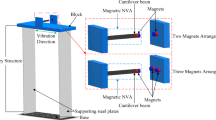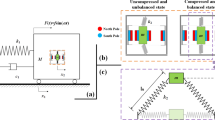Abstract
Purpose
A repulsive magnetic array negative stiffness structure (RMANSS) is proposed to achieve low-frequency micro-vibration isolation with large load capacity. The RMANSS utilizes a perpendicular magnetized magnetic array to maintain the repulsive magnetic force exhibiting linear and high negative stiffness, which offsets the stiffness of vibration isolators to the maximum extent and achieves high vibration isolation performance.
Methods
The theoretical model of magnetic force, stiffness and nonlinearity of RMANSS is established, and its effectiveness is validated by simulation. Based on the theoretical model, geometric parameters are optimized by the genetic algorithm. Furthermore, the performance of RMANSS is compared with three state-of-the-art magnetic negative stiffness structures.
Results and conclusion
Optimized stiffness at the equilibrium position is − 29.5 N/mm, and the nonlinearity at ± 1 mm is less than 0.5‰. Both negative stiffness and linearity of RMANSS are improved by one order of magnitude than those before optimization. Comparisons with three state-of-the-art magnetic negative stiffness structures show that magnetic array not only increases negative stiffness by a factor of 2, 10 and 5, reduces nonlinearity by 93.2%, 96.8% and 93.6%, respectively, but also ensures the best vibration isolation at the equilibrium position. So, the proposed RMANSS is applicable in fields requiring high-performance vibration isolation, such as advanced manufacturing, frontier scientific research, etc.












Similar content being viewed by others
References
Courtland R (2017) Moore’s law’s next step: 10 nanometers. IEEE Spectr 54(1):52–53
Ito S, Schitter G (2018) Atomic force microscopy capable of vibration isolation with low-stiffness Z-axis actuation. Ultramicroscopy 186:9–17
Deng L, Wu L, Chen P et al (2021) Effects of retracting velocities on the vibration of atomic force microscope probe on different surfaces. J Vib Eng Technol 9:1305–1315
Vo NYP, Nguyen MK, Le TD (2021) Analytical study of a pneumatic vibration isolation platform featuring adjustable stiffness. Commun Nonlinear Sci 98:105775
Suman S, Balaji PS, Selvakumar K et al (2021) Nonlinear vibration control device for a vehicle suspension using negative stiffness mechanism. J Vib Eng Technol 9:957–966
Oyelade AO (2019) Vibration isolation using a bar and an Euler beam as negative stiffness for vehicle seat comfort. Adv Mech Eng 11(7):1687814019860983
Sun XT, Jing XJ (2016) Analysis and design of a nonlinear stiffness and damping system with a scissor-like structure. Mech Syst Signal Proc 66–67:723–742
Wang XL, Zhou JX, Xu DL et al (2017) Force transmissibility of a two-stage vibration isolation system with quasi-zero stiffness. Nonlinear Dyn 87:633–646
Yonnet JP (2003) Passive magnetic bearings with permanent magnets. IEEE Trans Magn 14:803–805
Robertson WS, Kidner MRF, Cazzolato BS et al (2009) Theoretical design parameters for a quasi-zero stiffness magnetic spring for vibration isolation. J Sound Vib 326(1–2):88–103
Olaru R, Arcire A, Petrescu C et al (2017) A novel vibration actuator based on active magnetic spring. Sens Actuators A 264:11–17
Shan YH, Wu WJ, Chen XD (2015) Design of a miniaturized pneumatic vibration isolator with high-static-low-dynamic stiffness. J Vib Acoust 137 (4):045001
Zheng YS, Zhang XN, Luo YJ et al (2016) Design and experiment of a high-static-low-dynamic stiffness isolator using a negative stiffness magnetic spring. J Sound Vib 360:31–52
Zheng YS, Li QP, Yan B et al (2018) A stewart isolator with high-static-low-dynamic stiffness struts based on negative stiffness magnetic springs. J Sound Vib 422:390–408
Zhou ZH, Chen SH, Xia D et al (2019) The design of negative stiffness spring for precision vibration isolation using axially magnetized permanent magnet rings. J Vib Control 25(19–20):2667–2677
Wang Q, Zhou JX, Xu DL et al (2020) Design and experimental investigation of ultra-low frequency vibration isolation during neonatal transport [J]. Mech Syst Signal Proc 139:106633
Nijsse GJ (2001) Linear motion systems: a modular approach for improved straightness performance. Delft University of Technology, Delft
Carrella A, Brennan MJ, Waters TP et al (2008) On the design of a high-static-low-dynamic stiffness isolator using linear mechanical springs and magnets. J Sound Vib 315(3):712–720
Wang M, Chen XD, Li XQ (2016) An ultra-low frequency two DOFs’ vibration isolator using positive and negative stiffness in parallel. Math Probl Eng 2016:1–15
Wu WJ, Chen XD, Shan YH (2014) Analysis and experiment of a vibration isolator using a novel magnetic spring with negative stiffness. J Sound Vib 333(13):2958–2970
Chai K, Zhu S, Yang Q et al (2018) Analysis and test for the performances of a tri-magnet vibration isolator. J Vib Shock 37(006):36–41
Wu WJ (2014) Study on active precision vibration isolation system based on parallel of positive and negative stiffness springs. Huazhong University of Science and Technology, Wuhan
Allag H, Yonnet JP (1984) 3D analytical calculation of the forces exerted between two cuboidal magnets. IEEE Trans Magn 20(10):1962–1964
Janssen JLG, Paulides JJH, Lomonova E et al (2009) Analytical calculation of interaction force between orthogonally magnetized permanent magnets. Sens Lett 7(3):442–445
Acknowledgements
This research work is supported by National Natural Science Foundation of China (Grant No. 52075133).
Author information
Authors and Affiliations
Corresponding author
Ethics declarations
Conflict of interest
The authors declare that they have no known competing financial interests or personal relationships that could have appeared to influence the work reported in this paper.
Additional information
Publisher's Note
Springer Nature remains neutral with regard to jurisdictional claims in published maps and institutional affiliations.
Rights and permissions
About this article
Cite this article
Zhao, Y., Cui, J. & Zou, L. Genetic Optimization of Repulsive Magnetic Array Negative Stiffness Structure for High-Performance Precision Micro-vibration Isolation. J. Vib. Eng. Technol. 10, 1325–1336 (2022). https://doi.org/10.1007/s42417-022-00449-4
Received:
Revised:
Accepted:
Published:
Issue Date:
DOI: https://doi.org/10.1007/s42417-022-00449-4




